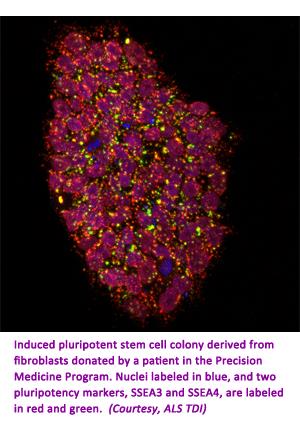The conversation about stem cells as a treatment for ALS has been going on for decades. While none of the approaches conducted in clinical trials have yet led to an FDA approval, there are several that are making progress. These include approaches from companies such as Neuralstem, Brainstorm Cell Therapeutics, Q Therapeutics as well as academic researcher initiated trials at the Mayo Clinic and Cedars-Sinai Medical Center.
The trial at Cedars-Sinai Medical Center recently began recruiting patients. With this in mind, the following reviews two of the most talked about stem cell programs in ALS in advance of a webinar on July 10, 2017 at Noon (ET) on the topic of Stem Cell Research in ALS.
CNS10-NPC-GDNF (Cedar-Sinai Medical Center)
 For more than a dozen years, Dr. Clive Svendsen and colleagues have been working on a unique approach to stem cell treatment in people with ALS. The idea they have been pursuing was built on the observation that the cells that support the health and integrity of the motor neurons called glial cells, become sick as the disease progresses. As a result, glia aren’t able to produce enough of a specific protein, called glial-derived neurotropic factor (GDNF), that motor neurons need to survive.
For more than a dozen years, Dr. Clive Svendsen and colleagues have been working on a unique approach to stem cell treatment in people with ALS. The idea they have been pursuing was built on the observation that the cells that support the health and integrity of the motor neurons called glial cells, become sick as the disease progresses. As a result, glia aren’t able to produce enough of a specific protein, called glial-derived neurotropic factor (GDNF), that motor neurons need to survive.
Svendsen and team engineered stem cells that would become glial cells that exude GDNF when placed into the spinal cord. Preclinical tests using rodent models proved successful and after nearly a decade of work on the stem cell engineering process, refining the manner in which the cells will be delivered to the spinal cord, and overcoming other important hurdles, the FDA approved a phase 1 clinical trial in October 2016.
This first human phase 1 trial aims to enroll 18 people with ALS at Cedars-Sinai in Los Angeles. All participants in this trial will receive spinal cord injections of CNS10-NPC-GDNF; there is no placebo arm in this study. The trial’s primary investigator Dr. Robert Baloh has set the enrollment criteria to include individuals whose FVC is greater than 60% and whose disease symptoms started 36 months ago, or less. Investigators are injecting the stem cells into the lumbar region of the spinal cord and assessing throughout the yearlong study if there are any negative side effects from treatment. Based on the results of this study, future trials may be designed to measure whether or not the treatment has an impact on disease progression.
More details on study design and contact information to pursue enrollment can be found online here.
NurOwn (Brainstorm Cell Therapeutics)
One of the most talked about stem cell approaches in the field of ALS today is on a product called NurOwn, developed by Brainstorm Cell Therapeutics. Based out of Israel, Brainstorm began testing their adult stem cell derived product, NurOwn, on people with ALS and other neurodegenerative diseases nearly 10 years ago. Since then, several small phase 1 and phase 2 clinical trials have occurred in people with ALS both in Israel and in the United States. NurOwn cells aim to enhance the production of neuroprotective neurotrophic factors (i.e. GDNF, BDNF, VEGF and HGF) in the spinal cord.
Most recently, one of the principal investigators of the US based trial, Dr. James Berry, reported outcomes at the International ALS/MND Research Symposium in Dublin. The 2:1 placebo controlled study included 46 people with ALS. Berry reported the treatment was safe and well tolerated by people with ALS. Brainstorm Cell Therapeutics announced that the initiation of a phase 3 efficacy trial in the US will begin before the end of 2017. The company is also exploring early access to NurOwn in Canada and Israel.
Other stem cell trials of note:
There have been several clinical trials in people with ALS done by Neuralstem (first single dose and then dose escalating) using embryonic derived stem cells. It is unknown whether the company will continue clinical trials in people with ALS.
Q Therapeutics is expected to soon open enrollment for a clinical trial of its stem cell product (Q Cells) in people with ALS later this year at Johns Hopkins University. This study has a much more liberal enrollment criteria than many others in the past, including individuals that have had ALS symptoms for as long as 48 months.
Over the last decade, technology advances have made it possible for scientists to create stem cells by reverse engineering them from skin, blood and other tissue samples from individual patients. Called induced pluripotent stem cells (iPSc), this approach has yet to find a path into clinical trial. However, iPSc technology is a key tool used in labs to study disease pathology at the cellular level, potentially helping identify new targets for subtypes of ALS in programs such as the Precision Medicine Program at the ALS Therapy Development Institute. Patients enrolled in clinical trials, stem cell or otherwise, can also use tools in that innovative program to track their disease progression before, during and following a clinical trial; empowering them to determine on their own if the experimental treatment impacted their disease progression in a positive way.
Finally, it is important to note that clinical trials on the use of stem cells in people with ALS don’t just occur in the United States. In fact, there are trials enrolling or on-going in South Korea, Brazil and Jordon, among others. If you are interested in exploring ongoing clinical trials please visit our clinical trials page online.
Resources: